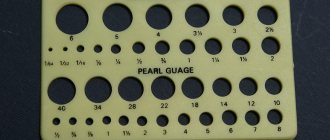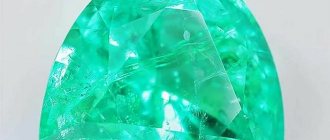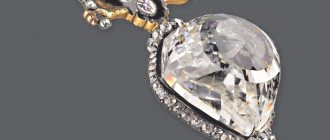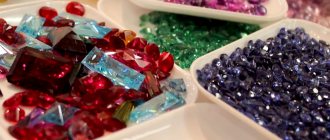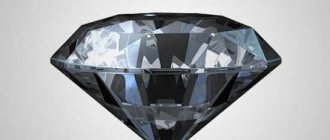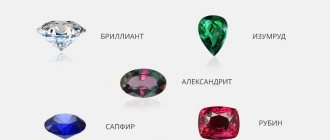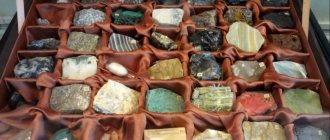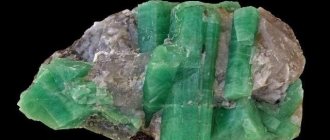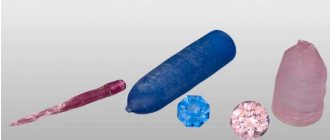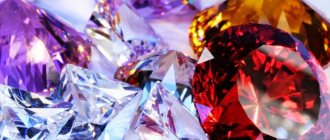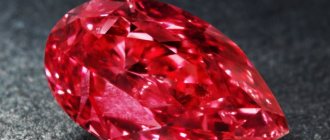Stones are an integral and ancient part of our nature. It is no coincidence that the Stone Age, which was the very first and longest in the history of mankind, is called the Stone Age. The world of stone is amazing and infinitely diverse - from road rubble and coastal pebbles to the rarest gems, which are valued at fabulous sums. They are credited with a special energy, a unique magical power that can influence a person and his life. There are absolutely amazing stones in the world that you cannot pass by indifferently, because they are the most...
Mysterious stone of China
This strange large stone was found in Hubei, a province in Central China. Allegedly, one Chinese noticed the edge of a stone formation sticking out of the ground in a mountainous area. He began to dig it out, and eventually saw what you see in the photo - a “layered” stone weighing six tons, in which each “layer” stands on columns. The Chinese liked the stone so much that he found the owner of this land, bought a cobblestone from him for 14 thousand dollars, brought it to his site and does not allow scientists or journalists to approach it.
Personally, I deeply doubt the veracity of this information. Why? In my opinion, when an artifact or something unknown is found, various specialists naturally begin to comprehensively study it in order to reliably find out its origin and age. And here the owner of the stone, having paid a tidy sum for it, brought a multi-ton find to his site and does not want to study it. Although the unusual shape of the find could be the work of Mother Nature or some ancient sculptor.
It seems to me that this is illogical. Unless the new owner of this cobblestone knows the true origin of the stone. Maybe for some reason he himself came up with this whole story? Otherwise, why is there not a single photograph depicting a stone in the ground as he first saw it? If the sight that immediately attracted the man's attention was so unusual, it would be natural to take a photo of the stone (fortunately, this is easy now). The same can be said about the moment of the “excavation” of the stone, if there really was one.
Artifact of Xia Chenghong
Both the shape of this stone and the history of its appearance are strange. In shape it could be similar to a fossilized fragment of a UFO mechanism (if it existed) weighing 6 tons and 2.8 m high. The two oval parts of the “three-story” artifact seem to be connected (or separated) by columns, and they can also be seen at the top. According to media reports, the discovery was made by Chinese Xia Chenghong, who drove past a piece of rock sticking out of the ground in a car. It caught his attention and he stopped. Seeing that the stone was something interesting, the Chinese decided to become the owner of a rare artifact and bought this piece of land from a local farmer in order to transport the find to his plot. It took a long time to dig it out of the ground, and when it turned out that its size and weight exceeded expectations, a crane was used.
Now the find is on the owner’s personal property, and he refuses to either sell it for research or allow it to be studied on his territory. Therefore, it is not yet possible to identify the fragment either with the historical era or with the intended purpose. All that has been established with a relative degree of certainty is that the material of the incomprehensible artifact is basalt.
Al Naslaa, Saudi Arabia
Al-Naslaa Stone
This famous stone, which attracts the attention of many tourists, is located in Saudi Arabia. You, of course, noticed something unusual about it - a perfectly even cut.
According to some scientists, the age of this crack is many thousands of years. But who did it? A representative of an ancient civilization that possessed technologies that made it possible to make perfectly straight cuts? Or maybe these are the tricks of Mother Nature? There is no answer to this question.
Each of the two parts of the stone stands on a small base, and at the same time Al-Naslaa is very stable! How can this be?
There is another attraction on Al-Naslaa - images of animals.
Tanzanite
Tanzanite is a rare mineral that was discovered in 1966 in the area of Mount Kilimanjaro. It got its name because it is mined only in Tanzania. Initially, tanzanite was mistaken for an ordinary sapphire, but already the following year it became clear that this was a special mineral.
Although tanzanite is a very rare stone, mined only in one deposit, it has acquired value not only for its rarity. The popularity of tanzanite was facilitated by a successful advertising campaign that promoted the unique color of the stone. The campaign attracted celebrities, including Hollywood film star Elizabeth Taylor.
The main colors of tanzanite are shades of blue and violet. Each stone is graded on a complex color scale. Tanzanite is an impeccable stone because it is pure, and even a person with perfect eyesight will not be able to see inclusions in it. The cost of tanzanite can reach several thousand dollars per carat.
The flying stone of Ishi-no-Hoden
Ishi-no-Hoden Stone, Japan
This mysterious cobblestone is located in the small Japanese town of Takasago. The weight of the stone is impressive - about six hundred tons, and its dimensions are considerable, but it was called the “Flying Stone”. Why?
Obviously, Ishi-no-Hoden is a man-made stone, a monolith that was supposed to become part of some structure, but for some reason was not completed...
Ishi-no-Hoden is a part of a mountain that was given this shape by unknown craftsmen. On its edges, grooves are visible, which, perhaps, should have served to move either this stone along some large surfaces, or vice versa.
Or maybe Ishi-no-Hoden was supposed to become a part in a very large structure, and the groove served to tightly connect its parts?
Japanese experts have thoroughly studied this stone using modern technology. However, this did not give any results - the age of Ishi-no-Hoden was not determined, and traces of the tools with which it was processed were also not found.
How are crystals formed?
In the depths of the Earth there is magma, in the process of slow cooling and solidification of which crystals of various minerals with different crystal structures are formed. Why is this happening? You already know that each substance has its own melting point, or crystallization, or solidification. Therefore, all substances found in magma solidify in turn, in accordance with the temperature at which they are able to take a crystalline form. Most of these crystals are gemstones.
Leaves covered with water crystals (frost)
Crystals can also form from steam. For example, the steam that you exhale during severe frosts turns into small white flakes. During the first autumn frosts, the grass and branches of low-growing shrubs can become covered with amazing crystals of frost, which disappears as the temperature rises.
Evaporation from solution is another way for crystals to form. For example, after water evaporates from a saturated brine solution, salt crystals will remain at the bottom of the container. Similar processes occur in nature. Under the rays of the hot summer sun, the water in the seas and salt lakes begins to evaporate. Salt crystals first float on the surface of the water and then settle to the bottom.
This is how natural salt deposits are formed.
Sayvit Stone, Peru
Sayvit Stone
On the banks of the Apurimac River in Peru, there lies a 4-meter granite stone, on the upper surface of which a miniature image of an ancient city is carved. The stone is many thousands of years old...
In this city of stone there are houses, temples, squares, and roads - everything is as it should be. It is clear that the ancient masters might have wanted to make a similar model of the city, but how did they achieve this? After all, working with granite (this is a very hard rock) is very difficult, and in order to cut out small parts with a clear shape in it, you need to have special tools. So they were there at that time?
Interesting fact. In the city of Sayvit stone there are canals for irrigating fields and drainage ditches for draining sewage. When it rains, these channels begin to function - water flows where it is needed!
Why and by whom was this model of the city made? No answer.
Nowadays, the Sayvit stone is a striking landmark of Peru, attracting numerous tourists.
Wheel of Spirits
Israel
Photo: israeltourism, CC BY-SA 2.0
On the Golan Heights in Israel, smooth circles of stones are laid out. In the very center there is a mound 2.5 times human height. In Arabic these wheels are called Rujm el-Khiri. In Hebrew - Gilgal-Rephaim, so according to the most romantic version, they were built by the Rephaim - giants from the Old Testament. It is possible that Ishtar and her husband Tammuz, the gods of fertility, were worshiped here. They also say that the Zoroastrians brought the bodies of the dead here to be pecked by birds and torn apart by wild animals. Or maybe it’s an observatory, a solar calendar, or a burial place - there is no general opinion among scientists, but it’s all the more interesting to formulate your own.
More on the topic: 14 places to visit in Israel
Zhumbaktas stone, Kazakhstan
Rock Zhumbaktas, Kazakhstan
It rises from the waters of the Kazakh Lake Borovoe.
Translated from Kazakh, “Zhumbaktas” means “mysterious stone”.
There is such a legend. In ancient times, one bai (Kazakh rich man) had a daughter. The girl was very beautiful and smart, so the most respected and rich people wooed her. But she fell in love with a poor guy, a handsome akyn (poet and singer). The young people understood that the girl’s relatives would never allow them to be together, so they decided to run away. Mounting their horses, they rushed away from their homes. Everything seemed to be going well, but when the lovers began to cross Lake Borovoe by boat, the girl’s brothers overtook them. One of them shot an arrow and killed the guy. He fell out of the boat and sank to the bottom. The bai's daughter began to cry and asked the Gods to turn her into stone so that she could remain here forever, next to her beloved. They complied with her request. Since then, the Zhumbaktas rock has risen in the middle of Lake Borovoe.
The most unusual minerals and more!
The variety of crystals in shape is very large. Crystals can have from four to several hundred facets.
But at the same time, they have a remarkable property - whatever the size, shape and number of faces of the same crystal, all flat faces intersect each other at certain angles. The angles between corresponding faces are always the same.
Rock salt crystals, for example, can have the shape of a cube, parallelepiped, prism, or a body of a more complex shape, but their faces always intersect at right angles. Quartz faces have the shape of irregular hexagons, but the angles between the faces are always the same - 120°.
The law of constancy of angles, discovered in 1669 by the Dane Nikolai Steno, is the most important law of the science of crystals - crystallography. Measuring the angles between the faces of crystals is of very great practical importance, since from the results of these measurements in many cases the nature of the mineral can be reliably determined. The simplest device for measuring crystal angles is an applied goniometer.
The use of an applied goniometer is only possible for studying large crystals; the accuracy of measurements made with its help is also low. to distinguish, for example, crystals of calcite and nitrate, similar in shape and having angles between the corresponding faces equal to 101°55′ for the first and 102°41.5′ for the second, using an applied goniometer.
Therefore, in laboratory conditions, measurements of angles between crystal faces are usually performed using more complex and accurate instruments.
An ore with unusual, long-prismatic crystals (tees?) of white cerussite. Flux Mine, Harshow District, Santa Cruz Co., Arizona, USA.
An openwork aggregate of small spherulites of bright green smithsonite. 79 Mine, Gila Co., Arizona, USA.
Large (about 15 cm) sample of needle-shaped aurichalcite. 79 Mine, Gila Co., Arizona, USA.
An old souvenir. A miner holds a sample of Arizona aurichalcite in his hands.
An intergrowth of lamellar crystals of dark red shigaite on pink rhodochrosite. N'Chwaning II Mine, N.Cape Prov., South Africa.
Crystals of regular geometric shape are rare in nature.
The combined action of such unfavorable factors as temperature fluctuations and close surroundings with neighboring solids does not allow the growing crystal to acquire its characteristic shape. In addition, a significant part of the crystals that had a perfect cut in the distant past managed to lose it under the influence of water, wind, and friction with other solids.
Thus, many rounded transparent grains that can be found in coastal sand are quartz crystals that have lost their edges as a result of prolonged friction against each other.
Spherolite (from the Greek - sphere - stone) is a complex mineral aggregate of a round shape, consisting of thin needle-shaped crystals and found in nature in the form of balls of a radial structure.
A bluish-green smithsonite spherulite from the collection of the Smithsonian Institution. Mammoth Mine, Tiger, Pinal Co., Arizona, USA. Both the mineral and the museum are named after one person, the English mineralogist James Smithson.
The wall of the cavity from the oxidation zone of the ore deposit is lined with bright blue current-acicular cyanotrichite. Grandview Mine, Coconino Co., Arizona, USA.
The question of the origin of most minerals in nature is closely related to the complex problem of the origin and development of the Earth. According to modern ideas, the Earth was formed by combining initially cold matter that was present in the solar system in the form of solid dust particles.
Due to the release of energy during the collision of particles, as well as due to a number of other energy sources, the Earth should have warmed up to 1000-2000 ° C. At such a high temperature, the layers close to the surface and not compressed by the pressure of the overlying layers should have melted.
In this molten layer, a separation of rocks occurred: less dense rocks, such as granites, floated to the surface, beneath them there was a layer of denser basalts and even lower - the rocks that make up the mantle. Gases released when the substance of the upper layer of the globe melted formed the Earth's atmosphere.
With the subsequent cooling of the Earth, the molten layers solidified and formed the earth's crust, and water vapor, after condensing from the atmosphere, created the World Ocean.
Similar aggregates of “cave pearls” are often formed in abandoned mine workings under waterfalls. Bisbee, Cochise Co., Arizona, USA.
Barite with sand inclusions (“rose”). Norman, Cleveland County, Oklahoma, USA.
Mascagnite. Rawat, Tajikistan. Antholites up to 3 cm on argillite. 10x4x5 cm.
Smithsonite. Kelley Mine, Nacimiento Mountains Distr., Sandoval Co., New Mexico, USA.
Pyrite. Fengjiashan district, Hubei, China.
Apophyllite on stilbite. Rahuri.India.
Cavansite on stilbite. Wagholi, Pune, Maharashtra, India.
Scolecite, calcite, stilbite, apophyllite. Mahodari, Nasik, Maharashtra, India.
Wulfenite is a relatively rare mineral from the scheelite group; minor ore of molybdenum and lead. Named after the Austrian naturalist F. C. Wulfen.
Usually found in the form of small tabular and pyramidal crystals. Often forms crystalline crusts and powdery deposits on the walls of voids; continuous masses are relatively rare.
Druses of split lamellar wulfenite crystals are yellowish-brown in color. Defiance Mine, Gleeson, Cochise Co., Arizona, USA.
A large and rich ore of monomineral lamellar wulfenite of yellow-brown color. Glove Mine, Santa Cruz Co., Arizona, USA.
An ore of remarkable color palette with lamellar yellow-orange wulfenite and emerald-green fine-crystalline dioptase. Mammoth-St. Anthony Mine, Tiger, Pinal Co., Arizona, USA.
Split crystals of pink manganocalcite from the Huanggang iron ore mine in Inner Mongolia province in China.
Rich druse of prismatic inderite crystals. Boron Open Pit, Boron, Kern Co., California, USA.
A small but very pleasant spherulite of fine-needle ulexite. Boron Open Pit, Boron, Kern Co., California, USA.
A superb antique example of wire silver. Himmelsfurst Mine, Freiberg, Saxony, Germany.
A remarkable druse of skeletal crystals (rhombododecahedrons) of andradite from a known occurrence on the island of Serifos in Greece.
Spectacular “herringbone” of yellow-orange mimetite spherulites. San Pedro Corralitos, Chihuahua, Mexico.
An intergrowth of rhombohedral calcite crystals sprinkled along the edges with fine-crystalline pririte. Chezhou Pref., Hunan Prov., China.
At the beginning it was already said about what natural geological processes exist. Most gemstones are formed through processes requiring high temperatures and pressures.
In order for a mineral to form a good crystal, it needs conditions for growth, i.e. free space. Typically, rocks are very dense, and the minerals that form in them have irregular shapes.
Transparent and almost ideal in shape, gem crystals are formed in crack cavities and other voids. Crystals of topaz, emeralds, tourmalines grow in chambers and pockets of pegmatites; crystals of amethyst, rock crystal, etc. grow in the cavities of quartz veins.
During exogenous processes, when destruction and weathering of rocks occurs, precious stones, as more stable, are protected and accumulated in the weathering crust and placers. This makes them more accessible to mining, because it is much easier to extract minerals from loose rocks than from hard rocks.
A classic example of polychrome elbaite from the lithium pegmatites of eastern Afghanistan. Paprok, Nuristan, Afghanistan.
A large sample of native sulfur crystals on light calcite. Cozzodisi Mine, Agrigento, Sicily, Italy.
Celestine with sulfur. Caltanisetta, Sicily, Italy. Sample: Min. museum named after A.E. Fersman RAS.
KUTNAGORIT. Color - pink, red-brown, brown. The crystals form fibrous-bundled aggregates, as well as dense masses with a kidney-shaped surface. Kutnahorite is formed by replacing calcite. Many mineral specimens identified as rhodochrosite are actually cutnahorite. Valued by collectors for its rarity, especially from the mines near Braunschweig.
Druze of sheaf-shaped intergrowths of pink kutnahorite. N'Chwaning II Mine, Kalahari (Mn) fields, Northern Cape Prov., S. Africa.
Druze of sheaf-shaped intergrowths of pink kutnahorite. N'Chwaning II Mine, Kalahari (Mn) fields, Northern Cape Prov., S. Africa.
Seraphinite or clinochlore is a complex-structured silicate from the chlorite group. It has a beautiful green or even greenish-blue hue, is completely opaque, and has a charoite-like pattern. By the way, seraphinite is mined only in Russia, like charoite.
Clinochlore (polished section ~17x10 cm). Korshunovskoye deposit, Irkutsk region.
Transparent clinochlore crystals up to 4 mm in size with yellow grossular crystals up to 1 mm in size on the rock.
Bazhenovskoye field. Sverdlovsk region, Northern Urals.
Halite. Advance mine, Yerevan, Armenia. Sample: Geological-mineral. MGOU Museum
Gypsum is one of the most common minerals in the world and belongs to the sulfate class. Its name comes from the Greek “gipsos” - “boiling stone”, that is, gypsum or chalk. Gypsum is also called silkspar, Ural selenite (a fibrous type of gypsum), gypsum spar, maiden glass, alabaster (a granular type of gypsum).
I have a small sample of plaster, it is incredibly beautiful!
Gypsum consists of thin and thick tabular crystals with a glassy sheen (selenite, on the contrary, shines like silk). They have perfect cleavage in one direction, that is, the gypsum splits into thin plates. Gypsum is white, often transparent, but sometimes gray, sometimes reddish; the color can be yellowish, pinkish or brown if there are impurities.
Gypsum (with inclusions of Fe oxides), chalcocite. Blyava, Yu. Ural, Russia. More than 10x10 cm.
Calcite.
Translated from Latin, “calcite” means lime. This stone was formed as a result of centuries-old evaporation of calcium-containing solutions, and only a small part of calcite is of igneous and metamorphic origin. In terms of its chemical composition, the crystal is ordinary calcium carbonate.
Calcites are found in various colors: colorless, gray and gray-green, yellow, pink, white. The rarest specimens are black, their color is due to the high content of bitumen.
My favorite color among blue stones.
And there is also such calcite.” Rapunzel, let go of your braids..."
Calcite. Museum Cave, Altai, Russia.
Crystals vary in size. Many of them can only be seen properly with magnification.
Polished piece of Mexican fire agate, 4x magnification.
Or into a microscope.
A particle of a crystal of the phosphate mineral cacoxenite, magnified 18 times.
Cacoxenite is a very rare mineral translated from Greek as “bad guest.” This is due to the fact that it often contains phosphorus.
But there are giant crystals weighing several tons.
Pebbles at the entrance to the Mining Museum. Zmeinogorsk (Altai, Russia). In the center is a block of Revnev jasper.
It would seem that the cold order in crystals is so far from living nature.
It’s not for nothing that the Snow Queen in Andersen’s fairy tale forced Kai to fold regular geometric patterns from ice floes so that he would forget about warm human feelings.
And yet, recently it has become increasingly clear that it is the laws of order that provide the key to understanding the secrets of life. A crystal usually serves as a symbol of inanimate nature. However, the line between living and non-living is very difficult to establish, and the concepts of “crystal” and “life” are not mutually exclusive.
The creations of nature are beautiful and symmetrical and this is an inseparable property of natural harmony!!!
Lastly, a horror story))) The price is given simply for, let’s say, comparison of the value of minerals..
The skull is carved from aquamarine, 51x36x53 mm. Price: $1699.
Pink aragonite, 126x86x95 mm. Price: $189.
White coral, 130x87x100 mm. Price: $269.
Ammonite and coral. Alien (interpretation).
Thank you for your attention)))
Regards, Tatiana.
Moonstone, Peru
Stone “Killarumiyoc”
Near the Peruvian city of Cusco there is an archaeological park in which there are many ancient artifacts that have become landmarks of the country and attracting numerous tourists. Interest in these objects is explained not only by their appearance and venerable age, but also by the secrets surrounding them.
In this park there is a huge stone “Killarumiyoс”, which translated from the Quechua (South American Indian) language means “Moon stone”. On the “title” surface of this megalith there is a hollow in the shape of a “lobe” of a sphere. It seems that when creating it, ancient craftsmen used the most precise drawing tools and equipment, which allowed them to make a perfectly flat surface. Modern experts claim that this cannot be done using ancient hand tools! Therefore, thousands of years ago the Quechua people had the technology to do something like this?
Why did they need the Moonstone? According to scientists, for the Indians it was a place for various religious ceremonies.
Torburnite – mesmerizing and deadly beauty
This breed is named after its discoverer, the chemist Thorbern Bergman from Sweden. It occurs as a result of the interaction of water, copper, phosphorus and uranium. Such an unusual combination provides a rich dark olive color and an amazing structure of the mineral - its deposits (located in France, the Czech Republic, the Federal Republic of Russia, England, Poland and the USA) look like scatterings of emerald prisms! It is not surprising that even experienced crystallographers want to touch green stones and take a closer look at them.
But indulging such desires is extremely dangerous. Magic crystals are saturated with a gas called radon, as well as uranium. There is so much of the latter that these nuggets serve geologists as a reliable indicator of uranium deposits. These substances, as well as their breakdown products, emit radioactive alpha particles that destroy living cells . This process occurs as follows: microscopic pieces of the mineral enter the body with inhaled air or water. Long-term contact with them almost always ends in the development of lung cancer, leukemia or other serious diseases.
An ordinary person is unlikely to find his way into carefully guarded torbernite deposits or into laboratories studying it. But this does not mean that you are completely protected from poisonous stones. They can be contained in one of the most popular building materials - natural granite. Therefore, when choosing slabs for finishing your home, avoid those that contain attractive green inclusions!
Stone balls
Stone balls
These strange stone balls can be seen in many parts of our planet - on Franz Josef Land (an archipelago in the Arctic Ocean), and in warm New Zealand, and in Europe, and in Russia, and in Kazakhstan, and in the Central American Costa -Rike. Moreover, in the latter there are the most of these “balls” scattered.
Another name for the “balls of the gods” is “moeraki”.
Some stone balls are several meters in diameter and weigh several tons, while others are very small. The age of the oldest stone exceeds 12 thousand years. Solid!
What is the origin of the Moeraks? Previously it was believed that they were the work of human hands. Centuries ago, some people believed that these balls contained treasures. Therefore, lovers of easy money broke them or blew them up, but found nothing inside. So from some of the Balls of the Gods there were only fragments left...
Some scientists believe that such balls were an “architectural delight” on the homesteads of rich people of that time. Perhaps this was the case in populated parts of the Earth. But this does not mean that the Balls of the Gods were made specifically for this purpose. Then the question is: who made them and why, for example, on Franz Josef Land?
And then some experts began to prove that Moeraks were fossilized dinosaur eggs, while others argued that they were somehow connected with UFOs.
Some of our contemporaries believe that the “balls of the gods” are the creation of man, but representatives of official science say that they are the work of Mother Nature. For thousands of years, around some small formation, rock particles were layered and firmly fastened together, and rain and wind polished them - and this is how perfectly smooth spherical moraks were obtained.
Balancing cobblestones
No matter how amazing gems and precious stones are, people are no less fascinated by such a miracle of nature as cobblestones of impressive size, which literally stay on their word of honor, and sometimes stay that way for thousands of years! One striking example is the area near the San Bernardino Mountains, a short distance from the Las Vegas highway. More recently, just a few years ago, huge boulders were discovered here, frozen in unimaginably unstable positions from the point of view of visual perception. They are located very close to the San Andreas Fault. What amazes scientists is not even the fact that they stand and do not fall, but the fact that earthquakes of significant amplitudes are observed in this area, the epicenter of which is only a few kilometers away from the amazing place. At the same time, the cobblestones do not even move from their places, which literally baffles local seismologists. Moreover, some of them would not be difficult to swing with your hands, but they have been standing in their places, according to researchers, for several thousand years.
"Tumbling stones" have been found in completely different places around the world. The reason for their occurrence is simple - washing out and weathering of softer rocks. At the same time, scientists claim that there are fewer and fewer of them on earth.
Meredith stone
Meredith Stone
This artifact was discovered in the American city of Meredith (New Hampshire) in 1872, when Seneca Ladd, with the help of general workers, was excavating on his site.
The find has an ovoid shape and, as it turned out later, is made of quartzite. Its height is 10 cm, width is 6.5 cm. The face of a man, something similar to corn, as well as some circles and dots are carved on the stone. There are holes on the sides of the “face”.
After Seneca Ladd's death, the stone passed to his daughter, who donated the artifact to the New Hampshire State Historical Society.
Presumably, the Meredith stone was made by the native Indians of those places.
Eremeevit
Eremeevit is a borate (boron salt) of aluminum with the addition of fluorine. It was first discovered in 1883 on Mount Soktui in Transbaikalia. Named in honor of the Russian mineralogist P.V. Eremeev. It is found in the Pamir Mountains in Tajikistan, Namibia and in one area in Germany.
It is considered a fairly hard (7.5 on the Mohs scale) stone, comparable to quartz. Therefore, eremeevite is excellent for jewelry. One carat of the mineral costs about $2 thousand, and a gram cut stone costs $10 thousand.
Maiden stone
The Maiden's Stone
The Maiden's Stone is located in Kolomenskoye, in the Golosov ravine. This five-ton giant is about five thousand years old. Scientists believe that in pre-Christian times, sacrifices to the Gods were made on it.
But even today, the Maiden Stone supposedly has not lost its magical properties - it can grant wishes and heal from illnesses. Why was it called "girlish"? Because women believe that he can give them the pregnancy they want.
Maiden stone is a quartz sandstone, the surface of which consists of many hemispheres of different sizes.
Galena – toxic symmetry
Galena deposits are easy to recognize - they consist of scatterings of small glittering cubes, each face of which is clearly defined and proportional to the others. And the steel, silver or bluish tint of the mineral immediately attracts the eye with its sparkle and brilliance. When looking at these crystals, associations arise in your head with the high-tech style, deep space and avant-garde statues. It seems incredible that nature could create such a symmetrical and proportionate creation!
But beauty is not the only advantage of galena. For a long time it was the only source of lead, and because of this, the second name of the mineral is lead luster. To obtain this heavy metal, pieces of stone were simply thrown into a fire. This method was known to the Greeks, Phoenicians and Romans. And if you hit the crystal with a hammer, a large fragment will scatter into many small ones, while maintaining a cubic structure. Such properties attract curious spectators who want to study the wonderful pebble... but the unusual toy can also be very dangerous.
It is known that people who have been in contact with galena often suffer from lung diseases - from shortness of breath to silicosis. The latter disease most often affects miners who mine lead ore - the dust rising from the mines penetrates the lungs, forming nodules on them. But even a simple touch of the mineral can lead to an exacerbation of asthma or a coughing attack.
Rock in the Mojave Desert (California, USA)
Mojave Desert Stone
It doesn’t matter how old this stone is. The main thing is that the indigenous Indians of America considered the desert where the stone lies to be a mysterious place with supernatural powers. Therefore, the stone was also magical.
In the twenties of the last century, sorcerers predicted that the day would come when the stone would split in two - and this happened in 2000.
And earlier, in the thirties of the last century, another story happened here. The German Frank Kritzen, an original who did not want to live among people, really liked this boulder. Together with his friend, he dug a cave under a rock and began to live in it. During World War II, US authorities considered Frank a spy and tried to arrest him. But the man had no intention of leaving the cave. Then the law enforcement officers opened fire, but one of the bullets hit a container of gasoline - a fire started and Frank Kritzen died.
Serpentinite
This general name refers to rocks consisting of fibrous chrysotile, lamellar antigorite, and massive lizardite. There are different types of serpentinite, differing in color (they can be green, gray, blue, blue and other shades), structure and texture. Dense serpentinite (which in Russia is traditionally called serpentine) with spotted patterns and beautiful shades is used as a material for cladding, making vases, souvenir eggs, boxes and other decorative items.
Waffle stone
Waffle Stone
Waffle Stone is located in the USA, in the state of West Virginia. Where this name comes from is clear if you look at the surface of this stone - intersecting lines are “painted” on it, reminiscent of a “pattern” on a wafer.
The boulder was discovered in 1930 near the bed of the Ptomak River during work on “digging” an artificial lake.
The age of this stone is about 300 million years, but when, who and why applied such a clear geometric pattern to it is unknown.
Some scientists believe that this was done by the masters of an unknown highly developed civilization that existed millions of years ago in these places.
Other scientists claim that the waffle pattern is a mark left by a UFO landing.
The Native American Indians considered the Waffle Stone sacred.
Amazing granite
Five interesting facts about this famous stone:
- The average age of the rock is 50 million years.
- For it to form in the thickness of the earth, monstrous pressure is required. It was thanks to him that part of the stone was subsequently squeezed out to the surface.
- Sound travels an order of magnitude faster in granite than in air.
- Located in the Himalayan mountains, the Kanchenjunga massif is famous for having a peak that is completely covered with granite.
- The colossal strength of this stone is guaranteed for up to 500 years in any climatic conditions!
Stones with gutters
Gotland Island Stone
More than a thousand of these stones are scattered across the Swedish island of Gotland. They were first discovered in the 19th century.
These stones are made of very hard rock, but their surface has grooves of varying lengths and widths. But who inflicted them and why?
According to one version, these were ancient sharpening stones, on which the men of those years sharpened their bladed weapons.
According to another version, the notches on the stones are a lunar calendar.
Subsequently, such stones were found in other European countries, as well as in Australia and India.
Stibnite - poisonous arrows
Stibnite (also known as stibnite, or antimony luster) is an unusual mineral composed primarily of antimony sulfide. It may also contain minor impurities of gold, silver, copper and iron. But this is not why it is valued - this breed is the main source of antimony, used in the production of semiconductors, weapons, bullets, matches and paints. And in ancient times it was used to make vessels and even blacken eyebrows!
This stone looks very beautiful. It resembles a bunch of sparkling steel swords - needle-shaped and prismatic crystals are collected in fan-shaped intergrowths. Their surface is painted in a lead-gray tone and has a strong metallic sheen. The largest deposits of the mineral are located in Japan - fragments reaching a length of up to 30 cm have been found there - as well as in China, Turkey and Central Asia.
Who discovered that beautiful stones are also very poisonous? According to legend, this discovery was made by the abbot of the monastery. Noticing that pigs were getting fat from eating antimony, he decided to test its effect on monks. To do this, the abbot began to mix crushed stibnite into the food - but all the people who tasted such dishes died in terrible agony. And modern mineralogists would never even touch a gem without special protection. The antimony it contains causes dermatitis, rhinitis, pneumonia, gastritis, conjunctivitis and can even cause cancer.
Horse-stone
Horse-stone, Russia
This stone is located on the island of Konevets, which is on Lake Ladoga (Russia). In ancient times, it was a sacred place for the ancient Karelians, where horses were sacrificed to the gods.
In the 14th century, the Monk Arseny Konevsky visited this place, which he considered demonic. He prayed all night, made a religious procession around the Horse-Stone and sprinkled it with holy water, after which evil spirits began to crawl out of the boulder. They turned into black ravens and flew away. Since then, the Horse-Stone has become Christian. And in 1985, the chapel of Arseny Konevsky was erected on it.
Arsenopyrite – fool's gold
The name arsenopyrite (also known as arsenic pyrite) comes from the Latin word “arsenicum”, which means “arsenic”. Therefore, arsenic pyrite is extremely dangerous, because this poison is still considered one of the deadliest. The stone also contains finely divided gold, which is the reason for the attractive shine that the prismatic nugget shimmers with. It was this feature that often became the reason that inexperienced miners mistook the rock for an ingot of precious metal... and as a result, they noted a sharp deterioration in their health.
But the most dangerous thing is to heat this stone. When the temperature rises, it releases toxic and carcinogenic fumes - inhaling them can lead to death in a matter of minutes. Fortunately, there is an unmistakable sign that allows you to recognize a dangerous mineral in time. This is a pungent garlic stench that is released when the crystal is damaged. You can feel it even by simply hitting a piece of rock with a hammer - the sparks that fall will be accompanied by a characteristic “aroma.” However, this smell was sometimes associated with the magical meaning of the stones - after all, garlic scares away vampires!
Arsenopyrite is quite widespread and is often found in quartz and fluorite rocks. In Ukraine, its deposits are in the Transcarpathian, Ivano-Frankivsk (Chivchyn Mountains), Krivoy Rog and Donetsk regions.
Blue stone
Blue Stone, Russia
Blue Stone is a sacred stone in Pereslavl-Zalessky.
Why was it called "blue"? Because after rain it changes its color from gray to blue. This is the property of the quartz biotite schist of which it is composed.
In pagan times, various rituals were performed on this 12-ton cobblestone, but even now it is popular because people believe in its magical powers.
In the Middle Ages, feasts and dances were held near the Blue Stone, which the priests really did not like. In the 17th century, churchmen buried this stone, but after some time it somehow unknown again appeared above the ground.
In the nineties of the 18th century, they decided to use the Blue Stone for the foundation of a church being built nearby. In the bitter cold, the boulder was loaded onto a powerful sleigh and transported across the ice of Lake Pleshcheevo. But the ice cracked and the stone sank. It would seem that's the end of the story. However, seven decades later, the stone “came out” onto land just north of the place where it had lain for many, many years!
Unfortunately, the Blue Stone is gradually going underground again. And no one can say for sure whether this is forever or whether it will return to the surface of the Earth again.
Coloradoite - the poison of the gold rush
This mineral was first found in Colorado (USA) among igneous rocks, which is why it received its name. This unique rock is a mercury telluride often found near gold deposits. It even looks like a granular scattering of tiny mercury balls, shimmering in black and steel colors with a rainbow tint.
Such nuggets were often mistaken for gold in the USA and Australia during the gold rush. They indeed contain a small amount of precious metal. But the danger posed by the unusual breed far outweighs the possible benefits. If you take it in your hands and warm it with the warmth of the human body, the mineral begins to release deadly steam - the ingress of its particles into the lungs and digestive tract can cause the development of tumors, ulcers and scars. A similar effect occurs even if you simply place coloradoite in direct sunlight. Therefore, on hot days, any activity aimed at extracting this stone is suspended.
